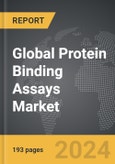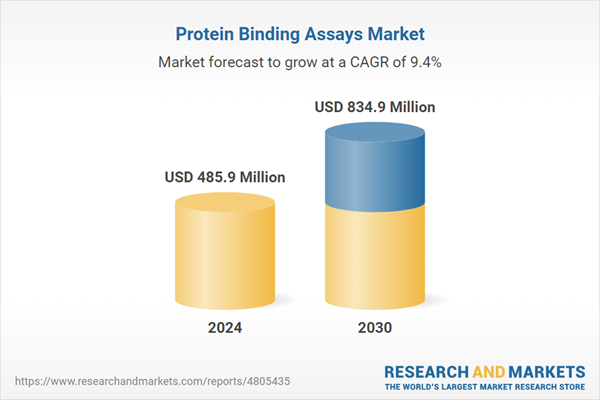The global market for Protein Binding Assays was valued at US$485.9 Million in 2024 and is projected to reach US$834.9 Million by 2030, growing at a CAGR of 9.4% from 2024 to 2030. This comprehensive report provides an in-depth analysis of market trends, drivers, and forecasts, helping you make informed business decisions. The report includes the most recent global tariff developments and how they impact the Protein Binding Assays market.
Segments: Technology (Equilibrium Dialysis, Ultrafiltration, Ultracentrifugation, Other Technologies); End-Use (Pharma & Biotech Companies, Contract Research Organizations, Research & Diagnostic Laboratories).
Geographic Regions/Countries: World; United States; Canada; Japan; China; Europe (France; Germany; Italy; United Kingdom; and Rest of Europe); Asia-Pacific; Rest of World.
The analysts continuously track trade developments worldwide, drawing insights from leading global economists and over 200 industry and policy institutions, including think tanks, trade organizations, and national economic advisory bodies. This intelligence is integrated into forecasting models to provide timely, data-driven analysis of emerging risks and opportunities.
Global Protein Binding Assays Market - Key Trends and Drivers Summarized
Understanding the Complexities: The Expanding Market for Protein Binding Assays
Protein binding assays are crucial tools in drug discovery and development, providing essential insights into the interactions between drugs and their target proteins. These assays help researchers determine the binding affinity of a drug to a protein, which is critical for understanding its pharmacokinetics, pharmacodynamics, and overall efficacy. The pharmaceutical and biotechnology industries heavily rely on these assays during the early stages of drug development to screen potential drug candidates and optimize lead compounds. As the demand for personalized medicine grows, protein binding assays play an increasingly vital role in identifying and developing drugs tailored to specific patient populations, making them indispensable in modern healthcare.How Are Technological Advancements Enhancing Assay Accuracy and Efficiency?
Technological advancements have significantly improved the accuracy, sensitivity, and efficiency of protein binding assays. The development of high-throughput screening (HTS) technologies has enabled the simultaneous analysis of thousands of compounds, accelerating the drug discovery process. Additionally, innovations in label-free detection methods, such as surface plasmon resonance (SPR) and isothermal titration calorimetry (ITC), have provided more precise measurements of binding interactions without the need for fluorescent or radioactive labels. These advancements have not only improved the reliability of the data generated by protein binding assays but have also reduced the time and cost associated with drug development. Furthermore, the integration of artificial intelligence (AI) and machine learning algorithms is enhancing the predictive capabilities of these assays, allowing for more accurate identification of potential drug candidates.What Role Does Regulatory Compliance Play in the Market?
Regulatory compliance is a significant factor driving the adoption of advanced protein binding assays in the pharmaceutical and biotechnology industries. Regulatory agencies such as the U.S. Food and Drug Administration (FDA) and the European Medicines Agency (EMA) require comprehensive data on drug-protein interactions as part of the drug approval process. This has led to an increased demand for assays that provide accurate and reproducible results, ensuring that drugs are both safe and effective. The stringent requirements for drug approval have pushed companies to adopt the latest assay technologies and methodologies, further driving innovation in the field. Additionally, the growing focus on biosimilars and biologics, which require detailed characterization of protein binding properties, has further increased the demand for advanced protein binding assays.What Are the Key Growth Drivers in the Market?
The growth in the protein binding assays market is driven by several factors. The increasing demand for personalized medicine and targeted therapies has spurred the need for more accurate and reliable protein binding assays. Technological advancements, such as the development of high-throughput screening technologies and label-free detection methods, have significantly improved the efficiency and accuracy of these assays, driving their adoption in drug discovery and development. Regulatory requirements for comprehensive data on drug-protein interactions have also played a crucial role in driving the market, as companies seek to ensure compliance with stringent safety and efficacy standards. Additionally, the growing focus on biologics and biosimilars, which require detailed protein characterization, is further propelling the demand for protein binding assays.Report Scope
The report analyzes the Protein Binding Assays market, presented in terms of units. The analysis covers the key segments and geographic regions outlined below.Segments: Technology (Equilibrium Dialysis, Ultrafiltration, Ultracentrifugation, Other Technologies); End-Use (Pharma & Biotech Companies, Contract Research Organizations, Research & Diagnostic Laboratories).
Geographic Regions/Countries: World; United States; Canada; Japan; China; Europe (France; Germany; Italy; United Kingdom; and Rest of Europe); Asia-Pacific; Rest of World.
Key Insights:
- Market Growth: Understand the significant growth trajectory of the Equilibrium Dialysis segment, which is expected to reach US$342.2 Million by 2030 with a CAGR of a 9.6%. The Ultrafiltration segment is also set to grow at 9.8% CAGR over the analysis period.
- Regional Analysis: Gain insights into the U.S. market, valued at $134.7 Million in 2024, and China, forecasted to grow at an impressive 8.8% CAGR to reach $127.7 Million by 2030. Discover growth trends in other key regions, including Japan, Canada, Germany, and the Asia-Pacific.
Why You Should Buy This Report:
- Detailed Market Analysis: Access a thorough analysis of the Global Protein Binding Assays Market, covering all major geographic regions and market segments.
- Competitive Insights: Get an overview of the competitive landscape, including the market presence of major players across different geographies.
- Future Trends and Drivers: Understand the key trends and drivers shaping the future of the Global Protein Binding Assays Market.
- Actionable Insights: Benefit from actionable insights that can help you identify new revenue opportunities and make strategic business decisions.
Key Questions Answered:
- How is the Global Protein Binding Assays Market expected to evolve by 2030?
- What are the main drivers and restraints affecting the market?
- Which market segments will grow the most over the forecast period?
- How will market shares for different regions and segments change by 2030?
- Who are the leading players in the market, and what are their prospects?
Report Features:
- Comprehensive Market Data: Independent analysis of annual sales and market forecasts in US$ Million from 2024 to 2030.
- In-Depth Regional Analysis: Detailed insights into key markets, including the U.S., China, Japan, Canada, Europe, Asia-Pacific, Latin America, Middle East, and Africa.
- Company Profiles: Coverage of players such as Absorption Systems LLC, ADMEcell, Inc., Biotium, Inc., Danaher Corporation, Eurofins Scientific and more.
- Complimentary Updates: Receive free report updates for one year to keep you informed of the latest market developments.
Some of the 44 companies featured in this Protein Binding Assays market report include:
- Absorption Systems LLC
- ADMEcell, Inc.
- Biotium, Inc.
- Danaher Corporation
- Eurofins Scientific
- GE Healthcare Life Sciences
- HTDialysis, LLC
- Merck & Co., Inc.
- Sovicell GmbH
- Thermo Fisher Scientific, Inc.
Tariff Impact Analysis: Key Insights for 2025
Global tariff negotiations across 180+ countries are reshaping supply chains, costs, and competitiveness. This report reflects the latest developments as of April 2025 and incorporates forward-looking insights into the market outlook.The analysts continuously track trade developments worldwide, drawing insights from leading global economists and over 200 industry and policy institutions, including think tanks, trade organizations, and national economic advisory bodies. This intelligence is integrated into forecasting models to provide timely, data-driven analysis of emerging risks and opportunities.
What’s Included in This Edition:
- Tariff-adjusted market forecasts by region and segment
- Analysis of cost and supply chain implications by sourcing and trade exposure
- Strategic insights into geographic shifts
Buyers receive a free July 2025 update with:
- Finalized tariff impacts and new trade agreement effects
- Updated projections reflecting global sourcing and cost shifts
- Expanded country-specific coverage across the industry
Table of Contents
I. METHODOLOGYII. EXECUTIVE SUMMARY2. FOCUS ON SELECT PLAYERSIII. MARKET ANALYSISIV. COMPETITION
1. MARKET OVERVIEW
3. MARKET TRENDS & DRIVERS
4. GLOBAL MARKET PERSPECTIVE
UNITED STATES
CANADA
JAPAN
CHINA
EUROPE
FRANCE
GERMANY
ITALY
UNITED KINGDOM
REST OF EUROPE
ASIA-PACIFIC
REST OF WORLD
Companies Mentioned (Partial List)
A selection of companies mentioned in this report includes, but is not limited to:
- Absorption Systems LLC
- ADMEcell, Inc.
- Biotium, Inc.
- Danaher Corporation
- Eurofins Scientific
- GE Healthcare Life Sciences
- HTDialysis, LLC
- Merck & Co., Inc.
- Sovicell GmbH
- Thermo Fisher Scientific, Inc.
Table Information
| Report Attribute | Details |
|---|---|
| No. of Pages | 193 |
| Published | April 2025 |
| Forecast Period | 2024 - 2030 |
| Estimated Market Value ( USD | $ 485.9 Million |
| Forecasted Market Value ( USD | $ 834.9 Million |
| Compound Annual Growth Rate | 9.4% |
| Regions Covered | Global |









